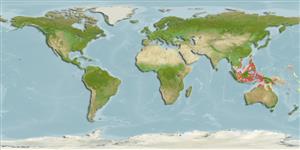>
Eupercaria/misc (Various families in series Eupercaria) >
Labridae (Wrasses) > Corinae
Etymology: Halichoeres: Greek, als, alis = salt + Greek, choiros = pig (Ref. 45335).
More on author: Bleeker.
Environment: milieu / climate zone / depth range / distribution range
Écologie
marin récifal; profondeur 2 - 25 m (Ref. 9710). Tropical
Western Central Pacific: known only from Indonesia and Philippines.
Taille / Poids / Âge
Maturity: Lm ? range ? - ? cm
Max length : 18.5 cm SL mâle / non sexé; (Ref. 2136)
Description synthétique
Clés d'identification | Morphologie | Morphométrie
Épines dorsales (Total) : 9; Rayons mous dorsaux (Total) : 12; Épines anales: 3; Rayons mous anaux: 12; Vertèbres: 25. Live females pinkish anteriorly; a black on each scale except those on thorax and most of the abdomen; head light salmon; a small dark spot behind eye; a broad transverse black band at the middle of the pelvic fins. Head of male greenish with irregular light-red bands; no black band between pelvic fins. Anterior lateral line scales with 1-3 pores; 8-13 suborbital pores. Anterior dorsal and anal soft rays longer than posterior rays; pelvic fins of males reaching the anus. Juveniles recognized by the green tail (Ref. 48636).
Inhabits outer reef flats and upper slopes of coastal reefs to depths over 25 m (Ref. 9710), with rich coral and hydrozoan growth. Found on sand-rubble fringe, coastal and lagoon reefs at 2-12 m (Ref. 90102). Usually seen solitary (Ref. 48636).
Life cycle and mating behavior
Maturities | Reproduction | Spawnings | Egg(s) | Fecundities | Larves
Distinct pairing during breeding (Ref. 205).
Randall, J.E., 1980. Two new Indo-Pacific labrid fishes of the genus Halichoeres, with notes on other species of the genus. Pac. Sci. 34(4):415-432. (Ref. 2136)
Statut dans la liste rouge de l'IUCN (Ref. 130435)
Menace pour l'homme
Harmless
Utilisations par l'homme
Pêcheries: commercial; Aquarium: Commercial
Outils
Articles particuliers
Télécharger en XML
Sources Internet
Estimates based on models
Preferred temperature (Ref.
123201): 27.8 - 29.2, mean 28.8 °C (based on 1106 cells).
Phylogenetic diversity index (Ref.
82804): PD
50 = 0.5000 [Uniqueness, from 0.5 = low to 2.0 = high].
Bayesian length-weight: a=0.00955 (0.00451 - 0.02020), b=3.09 (2.92 - 3.26), in cm total length, based on LWR estimates for this Genus-body shape (Ref.
93245).
Niveau trophique (Ref.
69278): 3.5 ±0.5 se; based on size and trophs of closest relatives
Résilience (Ref.
120179): Milieu, temps minimum de doublement de population : 1,4 à 4,4 années (Preliminary K or Fecundity.).
Fishing Vulnerability (Ref.
59153): Low vulnerability (13 of 100).
Nutrients (Ref.
124155): Calcium = 74 [44, 121] mg/100g; Iron = 0.659 [0.387, 1.211] mg/100g; Protein = 18.5 [15.6, 20.6] %; Omega3 = 0.147 [0.096, 0.225] g/100g; Selenium = 22.7 [13.7, 40.3] μg/100g; VitaminA = 146 [45, 528] μg/100g; Zinc = 1.66 [1.16, 2.62] mg/100g (wet weight);
